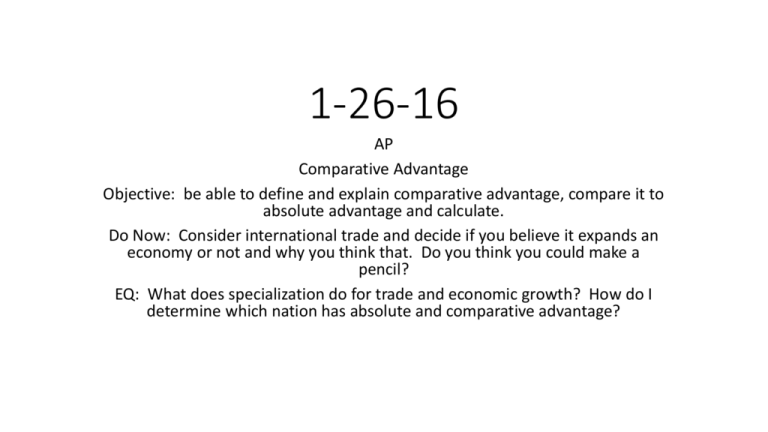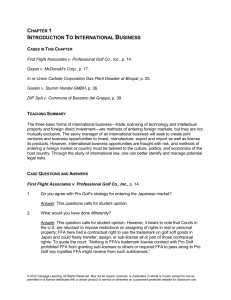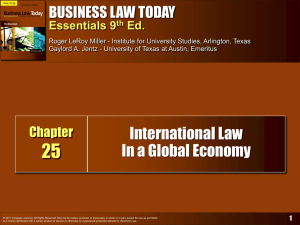
1-26-16
AP
Comparative Advantage
Objective: be able to define and explain comparative advantage, compare it to
absolute advantage and calculate.
Do Now: Consider international trade and decide if you believe it expands an
economy or not and why you think that. Do you think you could make a
pencil?
EQ: What does specialization do for trade and economic growth? How do I
determine which nation has absolute and comparative advantage?
BEFORE WE GET STARTED, ON THE ARTICLE “WHY SCARCE RESOURCES ARE SOMETIMES UNEMPLOYED”
What are the factors of production (the resources)?
What does inefficient have to do with unemployed use of resources? Why did they use Labor as an example?
What are the 3 types of unemployment?
How are frictional and structural similar? What is the significance of structural?
NROU is ? What unemployment is included?
What is cyclical?
How does it correlate to the business cycle?
What causes this form?
Can you explain underemployment?
Is labor the only resource unused? Explain?
• https://www.youtube.com/watch?v=67tHtpac5ws Friedman, Making
a Pencil 2.5 minutes
N. Gregory Mankiw
Economics
Principles of
Sixth Edition
3
Interdependence and the
Gains from Trade
© 2012 Cengage Learning. All Rights Reserved. May not be copied, scanned, or duplicated, in whole or in part, except for use as permitted in a license distributed with a certain
product or service or otherwise on a password-protected website for classroom use.
Premium PowerPoint
Slides by
Ron Cronovich
In this chapter,
look for the answers to these questions:
• Why do people—and nations—choose to be
economically interdependent?
• How can trade make everyone better off?
• What is absolute advantage?
What is comparative advantage?
How are these concepts similar?
How are they different?
© 2012 Cengage Learning. All Rights Reserved. May not be copied, scanned, or duplicated, in whole or in part, except for use as permitted in a license distributed with a certain
product or service or otherwise on a password-protected website for classroom use.
4
Interdependence
Every day
hair gel from
you rely on
Cleveland, OH
many people
cell phone
from around
from Taiwan
the world,
most of whom
dress shirt
you’ve never met,
from China
to provide you
with the goods
coffee from
and services
Kenya
you enjoy.
Interdependence
One of the Ten Principles from Chapter 1:
Trade can make everyone better off.
We now learn why people—and nations—choose to be
interdependent,
and how they can gain from trade.
© 2012 Cengage Learning. All Rights Reserved. May not be copied, scanned, or duplicated, in whole or in part, except for use as permitted in a license distributed with a certain
product or service or otherwise on a password-protected website for classroom use.
6
The opportunity cost can be determined by the
slope.
How many did you lose counting down and then
over to create a fraction.
© 2012 Cengage Learning. All Rights Reserved. May not be copied, scanned, or duplicated, in whole or in part, except for use as permitted in a license distributed with a certain
product or service or otherwise on a password-protected website for classroom use.
7
Our Example
Two countries: the U.S. and Japan
Two goods: computers and wheat
One resource: labor, measured in hours
We will look at how much of both goods
each country produces and consumes
if the country chooses to be self-sufficient
if it trades with the other country
© 2012 Cengage Learning. All Rights Reserved. May not be copied, scanned, or duplicated, in whole or in part, except for use as
permitted in a license distributed with a certain product or service or otherwise on a password-protected website for classroom use.
8
Production Possibilities in the U.S.
Get out graph paper and
create a PPC
The U.S. has 50,000 hours of labor
available for production, per month.
Producing one computer
requires 100 hours of labor.
Producing one ton of wheat
requires 10 hours of labor.
Based on this data how many computers
and tons of wheat can the US produce?
Create a PPC with wheat on the vertical and
computers on the horizontal.
© 2012 Cengage Learning. All Rights Reserved. May not be copied, scanned, or duplicated, in whole or in part, except for use as permitted in a license distributed with a certain
product or service or otherwise on a password-protected website for classroom use.
9
The U.S. PPF
Wheat
(tons)
The U.S. has enough labor
to produce 500 computers,
or 5000 tons of wheat,
or any combination along
the PPF.
5,000
4,000
3,000
2,000
1,000
0
Computers
100
200 300 400
500
© 2012 Cengage Learning. All Rights Reserved. May not be copied, scanned, or duplicated, in whole or in part, except for use as
permitted in a license distributed with a certain product or service or otherwise on a password-protected website for classroom use.
10
The U.S. Without Trade
Wheat
(tons)
Suppose the U.S. uses half its labor
to produce each of the two goods.
Then it will produce and consume
250 computers and
2500 tons of wheat.
5,000
4,000
3,000
2,000
1,000
0
Computers
100
200 300 400
500
© 2012 Cengage Learning. All Rights Reserved. May not be copied, scanned, or duplicated, in whole or in part, except for use as
permitted in a license distributed with a certain product or service or otherwise on a password-protected website for classroom use.
11
ACTIVE LEARNING
1
Derive Japan’s PPF
Use the following information to draw Japan’s PPF.
Japan has 30,000 hours of labor available for
production, per month.
Producing one computer requires 125 hours of
labor.
Producing one ton of wheat requires 25 hours
of labor.
Your graph should measure computers on the
horizontal axis.
© 2012 Cengage Learning. All Rights Reserved. May not be copied, scanned, or duplicated, in whole or in part, except for use as
permitted in a license distributed with a certain product or service or otherwise on a password-protected website for classroom use.
Japan’s PPF
Wheat
(tons)
Japan has enough labor to
produce 240 computers,
or 1200 tons of wheat,
or any combination
along the PPF.
2,000
1,000
0
Computers
100
200
300
© 2012 Cengage Learning. All Rights Reserved. May not be copied, scanned, or duplicated, in whole or in part, except for use as
permitted in a license distributed with a certain product or service or otherwise on a password-protected website for classroom use.
13
Japan Without Trade
Wheat
(tons)
2,000
Suppose Japan uses half its labor to
produce each good.
Then it will produce and consume
120 computers and
600 tons of wheat.
1,000
0
Computers
100
200
300
© 2012 Cengage Learning. All Rights Reserved. May not be copied, scanned, or duplicated, in whole or in part, except for use as
permitted in a license distributed with a certain product or service or otherwise on a password-protected website for classroom use.
14
Consumption With and Without Trade
Without trade,
U.S. consumers get 250 computers
and 2500 tons wheat.
Japanese consumers get 120 computers
and 600 tons wheat.
We will compare consumption without trade to consumption with
trade.
First, we need to see how much of each good is produced and
traded by the two countries.
© 2012 Cengage Learning. All Rights Reserved. May not be copied, scanned, or duplicated, in whole or in part, except for use as permitted in a license distributed with a certain
product or service or otherwise on a password-protected website for classroom use.
15
ACTIVE LEARNING
2
Production under trade
1. Suppose the U.S. produces 3400 tons of wheat.
How many computers would the U.S. be able to
produce with its remaining labor? Draw the
point representing this combination of
computers and wheat on the U.S. PPF.
2. Suppose Japan produces 240 computers.
How many tons of wheat would Japan be able
to produce with its remaining labor? Draw this
point on Japan’s PPF.
© 2012 Cengage Learning. All Rights Reserved. May not be copied, scanned, or duplicated, in whole or in part, except for use as
permitted in a license distributed with a certain product or service or otherwise on a password-protected website for classroom use.
U.S. Production With Trade
Wheat
(tons)
Producing 3400 tons of wheat
requires 34,000 labor hours.
5,000
4,000
The remaining 16,000
labor hours are used to
produce 160 computers.
3,000
2,000
1,000
0
Computers
100
200 300 400
500
© 2012 Cengage Learning. All Rights Reserved. May not be copied, scanned, or duplicated, in whole or in part, except for use as
permitted in a license distributed with a certain product or service or otherwise on a password-protected website for classroom use.
17
Japan’s Production With Trade
Wheat
(tons)
Producing 240 computers
requires all of Japan’s 30,000
labor hours.
2,000
So, Japan would produce
0 tons of wheat.
1,000
0
Computers
100
200
300
© 2012 Cengage Learning. All Rights Reserved. May not be copied, scanned, or duplicated, in whole or in part, except for use as
permitted in a license distributed with a certain product or service or otherwise on a password-protected website for classroom use.
18
Exports & Imports
Exports:
goods produced domestically and sold abroad
To export means to sell domestically produced goods abroad.
Imports:
goods produced abroad and sold domestically
To import means to purchase goods produced in other countries.
© 2012 Cengage Learning. All Rights Reserved. May not be copied, scanned, or duplicated, in whole or in part, except for use as permitted in a license distributed with a certain
product or service or otherwise on a password-protected website for classroom use.
19
ACTIVE LEARNING
3
Consumption under trade
Suppose the U.S. exports 700 tons of wheat to
Japan, and imports 110 computers from Japan.
(So, Japan imports 700 tons wheat and exports
110 computers.)
How much of each good is consumed in the
U.S.? Plot this combination on the U.S. PPF.
How much of each good is consumed in
Japan? Plot this combination on Japan’s PPF.
© 2012 Cengage Learning. All Rights Reserved. May not be copied, scanned, or duplicated, in whole or in part, except for use as
permitted in a license distributed with a certain product or service or otherwise on a password-protected website for classroom use.
U.S. Consumption With Trade
Wheat
(tons)
5,000
computers
produced
160
+ imported
110
wheat
3400
0
4,000
– exported
0
700
3,000
= amount
consumed
270
2700
2,000
1,000
0
Computers
100
200 300 400
500
© 2012 Cengage Learning. All Rights Reserved. May not be copied, scanned, or duplicated, in whole or in part, except for use as
permitted in a license distributed with a certain product or service or otherwise on a password-protected website for classroom use.
21
Japan’s Consumption With Trade
Wheat
(tons)
produced
+ imported
– exported
= amount
consumed
2,000
computers
240
0
110
wheat
0
700
0
130
700
1,000
0
Computers
100
200
300
© 2012 Cengage Learning. All Rights Reserved. May not be copied, scanned, or duplicated, in whole or in part, except for use as
permitted in a license distributed with a certain product or service or otherwise on a password-protected website for classroom use.
22
Trade Makes Both Countries Better Off
IT DOES
NOT MEAN
THAT THE
COUNTRIES
CAN
PRODUCE
MORE, BUT
THEY CAN
CONSUME
MORE!
U.S.
consumption
without trade
consumption gains from
with trade
trade
computers
250
270
20
wheat
2500
2700
200
Japan
consumption
without trade
consumption gains from
with trade
trade
computers
120
130
10
wheat
600
700
100
© 2012 Cengage Learning. All Rights Reserved. May not be copied, scanned, or duplicated, in whole or in part, except for use as
permitted in a license distributed with a certain product or service or otherwise on a password-protected website for classroom use.
23
Where Do These Gains Come From?
Absolute advantage: the ability to produce a good using fewer
inputs than another producer
The U.S. has an absolute advantage in wheat:
producing a ton of wheat uses 10 labor hours
in the U.S. vs. 25 in Japan.
If each country has an absolute advantage
in one good and specializes in that good,
then both countries can gain from trade.
© 2012 Cengage Learning. All Rights Reserved. May not be copied, scanned, or duplicated, in whole or in part, except for use as permitted in a license distributed with a certain
product or service or otherwise on a password-protected website for classroom use.
24
Where Do These Gains Come From?
Which country has an absolute advantage in computers?
Producing one computer requires
125 labor hours in Japan,
but only 100 in the U.S.
The U.S. has an absolute advantage in both goods!
So why does Japan specialize in computers?
Why do both countries gain from trade?
© 2012 Cengage Learning. All Rights Reserved. May not be copied, scanned, or duplicated, in whole or in part, except for use as permitted in a license distributed with a certain
product or service or otherwise on a password-protected website for classroom use.
25
Two Measures of the Cost of a Good
SOMETIMES THEY DO WITH
INPUT
OTHER TIMES IT IS OUTPUT
Two countries can gain from trade when each specializes in the
good it produces at lowest cost.
Absolute advantage measures the cost of a good in terms of the
inputs required to produce it.
Recall:
Another measure of cost is opportunity cost. (OUTPUT)
In our example, the opportunity cost of a computer is the amount of
wheat that could be produced using the labor needed to produce
one computer.
© 2012 Cengage Learning. All Rights Reserved. May not be copied, scanned, or duplicated, in whole or in part, except for use as permitted in a license distributed with a certain
product or service or otherwise on a password-protected website for classroom use.
26
Opportunity Cost and
Comparative Advantage
Comparative advantage: the ability to produce
a good at a lower opportunity cost than another
producer
Which country has the comparative advantage in
computers?
To answer this, must determine the opportunity
cost of a computer in each country.
© 2012 Cengage Learning. All Rights Reserved. May not be copied, scanned, or duplicated, in whole or in part, except for use as permitted in a license distributed with a certain
product or service or otherwise on a password-protected website for classroom use.
27
Opportunity Cost and
Comparative Advantage
The opportunity cost of a computer is
10 tons of wheat in the U.S., because producing
one computer requires 100 labor hours,
which instead could produce 10 tons of wheat.
5 tons of wheat in Japan, because producing
one computer requires 125 labor hours,
which instead could produce 5 tons of wheat.
So, Japan has a comparative advantage in
computers. Lesson: Absolute advantage is not
necessary for comparative advantage!
© 2012 Cengage Learning. All Rights Reserved. May not be copied, scanned, or duplicated, in whole or in part, except for use as permitted in a license distributed with a certain
product or service or otherwise on a password-protected website for classroom use.
28
Comparative Advantage and Trade
Gains from trade arise from comparative advantage (differences
in opportunity costs).
When each country specializes in the good(s)
in which it has a comparative advantage,
total production in all countries is higher,
the world’s “economic pie” is bigger,
and all countries can gain from trade.
The same applies to individual producers
(like the farmer and the rancher) specializing
in different goods and trading with each other.
© 2012 Cengage Learning. All Rights Reserved. May not be copied, scanned, or duplicated, in whole or in part, except for use as permitted in a license distributed with a certain
product or service or otherwise on a password-protected website for classroom use.
29
ACTIVE LEARNING
4
Absolute and comparative advantage
Argentina and Brazil each have 10,000 hours of
labor per month.
In Argentina,
producing one pound coffee requires 2 hours
producing one bottle wine requires 4 hours
In Brazil,
producing one pound coffee requires 1 hour
producing one bottle wine requires 5 hours
Which country has an absolute advantage in the
production of coffee? Which country has a
comparative advantage in the production of wine?
© 2012 Cengage Learning. All Rights Reserved. May not be copied, scanned, or duplicated, in whole or in part, except for use as
permitted in a license distributed with a certain product or service or otherwise on a password-protected website for classroom use.
ACTIVE LEARNING
Answers
4
Brazil has an absolute advantage in coffee:
Producing a pound of coffee requires only one
labor-hour in Brazil, but two in Argentina.
Argentina has a comparative advantage in wine:
Argentina’s opp. cost of wine is two pounds of
coffee, because the four labor-hours required
to produce a bottle of wine could instead
produce two pounds of coffee.
Brazil’s opp. cost of wine is five pounds of
coffee.
© 2012 Cengage Learning. All Rights Reserved. May not be copied, scanned, or duplicated, in whole or in part, except for use as
permitted in a license distributed with a certain product or service or otherwise on a password-protected website for classroom use.
Unanswered Questions…
We made a lot of assumptions about the quantities
of each good that each country produces, trades,
and consumes, and the price at which the countries
trade wheat for computers.
In the real world, these quantities and prices would
be determined by the preferences of consumers
and the technology and resources in both countries.
We will begin to study this in the next chapter.
For now, though, our goal was merely to see how
trade can make everyone better off.
© 2012 Cengage Learning. All Rights Reserved. May not be copied, scanned, or duplicated, in whole or in part, except for use as permitted in a license distributed with a certain
product or service or otherwise on a password-protected website for classroom use.
32
S U MMA RY
• Interdependence and trade allow everyone to
enjoy a greater quantity and variety of goods &
services.
• Comparative advantage means being able to
produce a good at a lower opportunity cost.
Absolute advantage means being able to produce
a good with fewer inputs.
• When people—or countries—specialize in the
goods in which they have a comparative
advantage, the economic “pie” grows and trade
can make everyone better off.
© 2012 Cengage Learning. All Rights Reserved. May not be copied, scanned, or duplicated, in whole or in part, except for use as
permitted in a license distributed with a certain product or service or otherwise on a password-protected website for classroom use.








